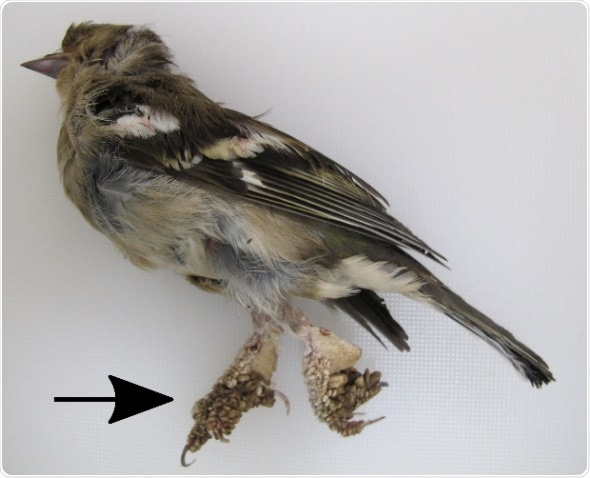Jul 27 2018
The discovery of microRNAs encoded by papillomaviruses supports the important role of these small molecules in persistent infection, according to a study published July 26 in the open-access journal PLOS Pathogens. Study author Rachel Chirayil of the University of Texas at Austin and colleagues made this discovery using a new approach that enables microRNA identification for the enormous range of pathogens that have genomic data but cannot be cultured in a laboratory setting.

The photograph is of one of the chaffinches with characteristic leg lesions used in preparation of the small RNA-seq libraries. Credit: Sullivan et al. (2018)
Papillomaviruses can cause several types of cancer in humans, but it remains unclear why only some infections lead to the development of malignant tumors. To answer this question, it’s necessary to better characterize papillomavirus gene products and their role in the life cycle of these pathogens. MicroRNAs are small RNAs that regulate diverse biological processes, including host-pathogen interactions. Consequently, microRNAs are commonly encoded by viruses that undergo long-term persistent infection. But until now, no widely accepted papillomavirus-encoded microRNAs had been discovered due in part to the lack of suitable laboratory models.
To overcome this hurdle, the researchers developed a new wet bench technology called microRNA Discovery by forced Genome Expression (miDGE). This broadly applicable methodology can screen numerous pathogen genomes in parallel, identifying microRNAs from organisms lacking a laboratory culture system. Using miDGE, they screened more than 73 different papillomavirus genomes for the ability to encode microRNAs.
Most papillomaviruses do not appear to code for microRNAs, but the researchers uncovered five new highly probable papillomavirus-encoded microRNAs. Although the papillomavirus microRNAs are not expressed in cancers associated with high-risk infection, some of them control viral gene expression. According to the authors, the findings suggest that microRNAs are important regulators of the papillomavirus life cycle.
“The most important aspect of this work is that this new technology opens up parallel study of numerous pathogens in a single experiment,” researcher Christopher Sullivan adds, “allowing for deep evolutionary cross comparisons. Here, insight from a bird virus helped us to understand why some human papilloma viruses do, and just as importantly, why most don’t, encode their own microRNAs.”